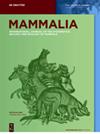Detection and characterization of zoonotic Bartonella spp. in rodents and shrews ectoparasites from Kigoma and Morogoro regions, Tanzania
IF 0.8
4区 生物学
Q3 ZOOLOGY
引用次数: 0
Abstract
Bartonellosis is a vector-borne disease which is increasingly threatening the health of humans and animals worldwide consequent to the growing wildlife-animals-human interactions. Little is known about the epidemiology of this disease in Tanzania. In this study we investigated and characterized坦桑尼亚基戈马和莫罗戈罗地区鼠类和鼩鼱中人畜共患巴尔通体外寄生虫的检测和鉴定
巴尔通体病是一种媒介传播的疾病,随着野生动物-动物-人类相互作用的增加,它正日益威胁着全世界人类和动物的健康。人们对这种疾病在坦桑尼亚的流行病学知之甚少。在本研究中,我们调查并鉴定了来自国内潜在高危地区的小型哺乳动物体表寄生虫中的巴尔通体种类。采用常规PCR和测序方法对141个螨、蚤、蜱、虱体外寄生虫池进行分析。体外寄生虫库中巴尔通体DNA检出率为34.8%,螨为32.9%,蚤为40%,蜱为12.5%,虱为50%。系统发育分析表明,该巴尔通体基因型与在乌干达、肯尼亚和南非发现的巴尔通体基因型密切相关。蚤类巴尔通体具有相同的单倍群,但不同的基因型具有独立的单倍型。野外和室内啮齿类动物中已证实存在伊丽莎白巴尔通体和摩擦体巴尔通体,这强调了在研究区域内外人畜共患感染的普遍传播风险。有必要对坦桑尼亚潜在高风险地区的人类、伴侣动物和牲畜进行筛查,以便为制定反应性监测和控制战略提供信息。
本文章由计算机程序翻译,如有差异,请以英文原文为准。
求助全文
约1分钟内获得全文
求助全文
来源期刊

Mammalia
生物-动物学
CiteScore
2.20
自引率
10.00%
发文量
68
审稿时长
6-12 weeks
期刊介绍:
Mammalia is an international, multidisciplinary, bimonthly journal devoted to the inventory, analysis and interpretation of mammalian diversity. It publishes original results on all aspects of the systematics and biology of mammals with a strong focus on ecology, including biodiversity analyses, distribution habitats, diet, predator-prey relationships, competition, community analyses and conservation of mammals. The journal also accepts submissions on sub-fossil or recently extinct mammals.
 求助内容:
求助内容: 应助结果提醒方式:
应助结果提醒方式:


